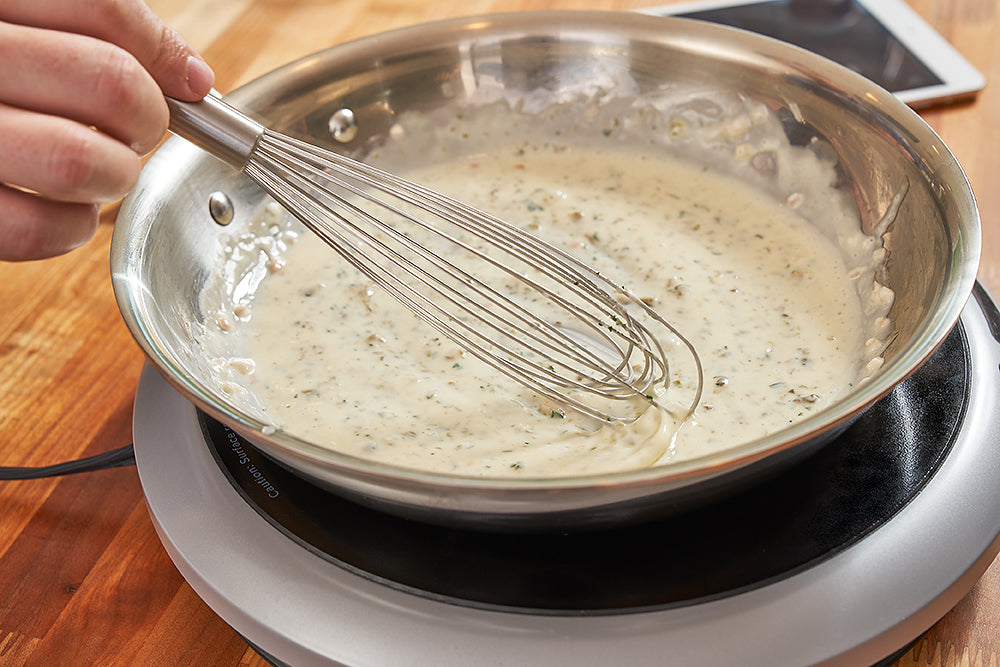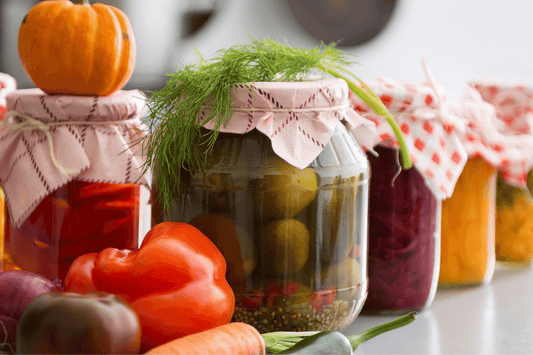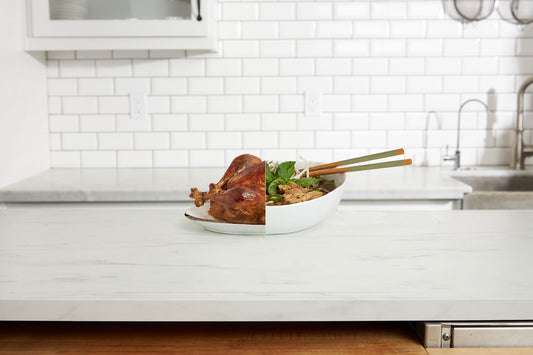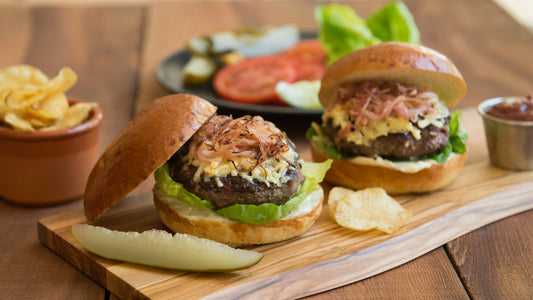The world of pan sauces is as diverse as the ingredients in your kitchen. Sadly, many people believe that the art of pan sauces starts and ends with wine deglazing, but there is a spectacular array of other techniques you can apply that will expand your pan sauce repertoire. Here is a rundown of all of the classic pan sauce techniques you can accomplish with your Cue.
Let’s start by describing the difference between a recipe and a technique. A technique is a set of steps with the purpose of creating a specific culinary result, like how deglazing cleans the bottom of a pan and captures the flavor of the caramelized fond. While a recipe is a selection of ingredients paired with techniques to produce a unique dish. Think of how searing a pork chop followed by deglazing the pan with marsala wine and quickly sauteing mushrooms and shallots results in Pork Marsala. Once you understand the techniques within a recipe, you can mix and match new ingredients to those same techniques to create entirely new dishes out of your imagination.

Classic Pan Sauce
Now that we’ve settled that, let’s talk about the classic pan sauce. When searing or roasting a protein or vegetable all the natural sugars attach to the pan creating a great caramelized layer that is packed with flavor. This is a mixture of the seasoning, the natural fats of the protein, the sugars on the ingredients (proteins have sugars too), the natural juices released during the cooking process and the oil, butter or lard used to actually cook the ingredients. This magical combination is what we call “fond".
Once you remove the food and uncover the fond, you add a liquid or more fat along with aromatics (shallots, mushrooms or capers) to lift up the fond and reduce. This results in a delicious sauce that incorporates the flavors of the previously cooked ingredients into a complementary sauce, which turns a regular night into something special...you go from simply eating to dining!

Now that we've covered the basics, let's expand our horizons. A pan is a great vessel for sauces because the height and size reduces liquids fast which in turn, develops flavor fast. Temperature plays a big part in the quality of a sauce just as much as it does for searing or baking. Pan sauces are susceptible to scorching, breaking, over reducing (creating a too thick or too salty of a sauce), or even under reducing resulting in a soupy and runny sauce. For instance, Brown Butter sauces are best cooked at 375ºF so they have enough time to brown and toast before burning. Cue's precise temperature can brown, reduce, thicken and finish the sauce while at the same time reducing the possibility of errors. By using the right temperature you can now achieve consistent results each and every time.
In this guide, we will cover four techniques for making pan sauces with your Cue: Reduction sauces, Brown Butter sauces, Emulsion sauces, and Broken Vinaigrettes.
Reduction Sauces
A reduction sauce is any sauce that reduces a volume of ingredients to produce a rich thickened sauce. Although all reduction sauces involve some amount of reduction, this isn't the only tool used to create a sauce consistency. Many reduction sauces use thickening agents like starches, jams, or cheeses to produce a sauce faster. In order to differentiate all of these sauces, we have separated this category into four key techniques.
Classic Reductions
A classic reduction sauce is as straightforward as it sounds: add cooking liquids (sous vide cooking juices, braising liquids or stock) into a hot pan and reduce until they coat the back of a spoon or you begin to see the bottom of the pan as you stir. We like to finish these sauces with butter and either vinegar or lemon juice to round out the flavor. You can also add in creme fraiche, heavy cream or sour cream for more viscosity and a smoother flavor. If you decide to use sour cream, be careful, since it is a relatively lean and acidic mixture of milk protein, water, and fat, it will curdle if it gets too hot. Only add the sour cream after you have removed the sauce from the heat. Reductions are great for saucing any proteins cooked sous vide or pan roasted. We recommend cooking reduction sauces at 300ºF (149ºC).

After searing your favorite cut of steak, follow along in the video below for our recipe for Red Wine Cream Sauce.
Semi-homemade Reductions
We call this a semi-homemade approach since this sauce starts by using a thick flavorful ingredient like mustard, jam, apple butter, honey, oyster sauce, and then thinning it out with a liquid like water, stock, braising liquids, cream, or deglazed fond. The mixture is then reduced back down to a sauce-like consistency resulting in a quick and tasty sauce that can be made in minutes. Examples include Teriyaki or Honey Dijon. Cooked at 275ºF (135ºC), these sauces are best for chicken, pork and beef, as well as noodles and stir fry dishes.

Cheese or Cream Sauces
Common cream and cheese sauces like Caccio e Pepe or Alfredo use reduced cream and melted cheese to produce a thick sauce, but you can create great results with either ingredient on its own. Cream, when it reduces will naturally produce the velvety sauce-like consistency we are looking for. A lower temperature of 250ºF (121ºC) is best for reducing cream since it has a tendency to boil over when it is reduced too quickly. Reduce heavy cream by half with aromatics to create a wonderfully simple sauce.
Grated cheese has the ability to thicken or tighten up any sauce in the same way as an Emulsion sauce. Simply adding grated cheese to a reduction of any sort will help achieve a more sauce-like consistency. We tend to use the term "tighten" when discussing cheese thickening because it has its limits. It can't turn water into sauce per se, but it can turn a slightly thickened reduction into a sauce. We like experimenting with Gruyere, Parmesan or Cheddar. Try adding parmesan cheese to freshly cooked pasta and a little bit of water for a simple Caccio e Pepe or melt it into a cream reduction for an Alfredo sauce.

Thickened Reductions
When it comes to reduction sauces sometimes we want to thicken without losing the volume. As we talked at the beginning of the category, reduction sauces are any sauce that reduces the volume of a liquid by simmering to a thick consistency. Sometimes we may not want to lose too much volume because we may be afraid the sauce will end up being overly seasoned. In these cases, we can use thickening ingredients. The most common ones are roux, beurre manié, and cornstarch.
Roux is a mixture of flour and fat (oil or butter), cooked together and used to thicken sauces. If you use a roux, you will start your sauce by making the roux, before adding milk, cream or broth (with or without aromatics) and cook it all together until it thickens. The recommended ratio for roux to liquid is 1 tbsp roux to 1 cup of liquid. Gravies and Bechamel sauces are typically thickened with roux.

Beurre manié is a thickening mixture made of melted butter and flour that is kept cold and added to hot soups or sauces as needed to thicken. Unlike roux, beurre manié is not cooked. Melt 1 part of butter and add 2 parts of flour. Mix until it becomes a thick paste, almost dough-like, and store in the fridge until needed. Beurre Manié is a Chef’s little secret to thicken sauces when a roux was not anticipated. It is perfect when you can’t change the volume but you need to change the consistency. The best thing about beurre manié is that it can be made in bulk and kept refrigerated until needed. This is your ace in the hole. It is most commonly used anywhere you would use a roux, “but forgot”. Try mornay sauces, volutes, and stews.

Cornstarch is a great gluten-free thickener. It helps thicken sauces quickly and makes sauces very stable. It has the ability to bind fats and proteins together which helps cornstarch sauces hold well over time. Cornstarch always has to be diluted in a cold liquid before being added to a sauce or it will clump up and never dissolve. You will often see cornstarch used in Asian inspired sauces like General Tso Chicken, or Sweet and Sour pork.

Brown Butter Sauces
Brown butter sauces include all recipes that start by browning the butter, a process in which the milk solids in butter are heated until they toast or “brown”. While the butter is browning additional ingredients are added to toast alongside the butter before the sauce is inevitably finished with a dash of acid like freshly squeezed lemon juice, vinegar or cherry tomatoes. The addition of moisture cools down the butter mixture stopping or significantly slowing the browning process. Additionally, the acid will balance the fatty-ness of the sauce. These liquid components mix with the butter and create a well balanced partially emulsified sauce.

Grenobloise or Sauce Meunière are typical brown butter sauces you may have seen. 375ºF (190ºC) is the perfect temperature to brown your butter without burning while making these sauces. Try the Almond and Apricot Brown Butter from the video below.
Since we mention both “Dry Ingredients” and “Wet Ingredients” for a Brown Butter Sauce, we decided to include some inspiration.
Dry ingredients are any item that doesn’t release many natural juices and has low acidity levels, like shallots, jalapeños, bell peppers, cauliflower florets, asparagus tips, chopped nuts, pumpkin seeds, diced bread, diced apples or pears.
Wet/Acidic Ingredients are vegetables or fruits with higher natural juices and acidity like capers, olives, cherry tomatoes, citrus segments, peaches, berries; as well as vinegar and citrus juices.
Emulsion Sauces
Beurre Blanc, Beurre Monté, and Hollandaise are the most famous emulsion sauces. This type of sauce is made from two liquids that can not naturally dissolve into one another. When an emulsion is created, the two ingredients (usually oil and water) are whisked or blended together to create a thick fluid where the oil particles have been evenly dispersed. This process is called emulsification.
For an emulsion to be successful it requires a key ingredient that has the ability to adhere to both the water and the oil holding them together. When cooking these key players are usually proteins like the whey protein in milk or lecithins like those found in soy and egg yolks. Emulsion sauces gain their sauce consistency from the thickening that occurs when the fat (oil or butter) is emulsified into the liquid (stock, vinegar, or cream).
The technique for an emulsified sauce has two specific parts. First, a reduction or base, followed by the emulsification process. The base is traditionally made by reducing wine and vinegar with herbs and spices, sometimes milk or cream is added to help the emulsification process. We recommend reducing your base at 350°F (190°C) on control mode.

Once the base is reduced, butter is slowly mixed in which emulsifies with the reduced liquids and thickens the sauce. This step is usually done off the heat to prevent the butter from breaking before it has had a chance to emulsify with the liquids. Once you understand the technique of emulsification, you can replace the wine and vinegar base for any liquid you want, get creative! Emulsion sauces are ideal for seafood, vegetables, beef, chicken, pork, lamb, pasta dishes or for adding into risottos as well as topping egg dishes.
For a twist on the traditional Beurre Blanc, try our recipe for Apple Cider Beurre Blanc in the video below.
Vinaigrette and Gastriques
These quick sauces can also be called “broken sauces”. This reference comes from the final visual result and it implies that the oil has not been fully incorporated into the sauce (like an emulsion sauce), resulting in a distinguishable “broken” or split texture. We can classify them into two main categories: warm vinaigrettes or gastriques. Both are typically cooked between 275°F (135°C) to 350°F (176°C).
Warm Vinaigrettes
Mostly made with olive oil, warm vinaigrettes start by charring or searing your selected dry ingredients like cherry tomatoes, peaches, pears, zucchini, peppers, before adding one part vinegar (soy sauce or citrus juice) and two parts olive oil. This mixture is then seasoned before serving. Look for the Warm Bacon Vinaigrette, Warm Tomato and Balsamic Vinaigrette, and Serrano Chile and Orange Vinaigrette in the Cue app.

Gastriques
This technique comes in handy when you want to really impress your friends and family. Reduce two parts vinegar, citrus juice, or tart fruit juice like pomegranate juice, with a liquid sugar like honey, maple syrup or jam, down to a syrup consistency. Once reduced add one part olive oil.

At this point, you can choose between fully incorporating the oil into the gastrique creating an emulsified gastrique or leaving it as a broken sauce. These sweet and sour reductions are great complementary additions to desserts, like the Molasses and Lemon Gastrique we showcase below.
Kitchen Sink Sauces
More than a single technique, this is a way of utilizing leftover ingredients. Create pan sauces utilizing leftover ingredients like veggie trim and pieces, olives from a cheese board, fruits, nuts, mustards, you name it! Don’t throw away food, just master the pan sauce techniques and you will be giving yourself a high five every night.
FAQ's
My sauce is too salty!
Before you toss the sauce away, add some lemon juice, sherry vinegar, red wine vinegar or lime juice to the sauce. Sometimes unbalanced flavors can give the idea of overly salty. Add the acid and taste again.
What is the best way to incorporate fresh herbs?
Adding fresh chopped herbs to finish sauces is an easy way to add extra flavor to a simple sauce. We know that everyone doesn’t always have fresh herbs handy. So you can always add chopped herbs and olive oil to an ice cube tray to create even portions and freeze until solid. Buy large amounts of herbs when they are in season, wash them and dry them well. Separate the leaves from the stems and chop the leaves finely. Once they are chopped, toss in a bowl will extra virgin olive oil and then portion out into ice cube trays (make sure to get the silicon trays for easy removal). Olive oil is the only oil that solidifies at low temperature. All other oils will remain liquid.
When do I add the cream?
When Using sour cream, cream cheese or creme fraiche, always remember that sour cream will break at high heat. So you always want to add sour cream once the sauce is off the heat and as a finishing touch. Creme fraiche and cream cheese resist temperature better and can be added while the sauce is still heating up.
My sauce is too think!
Add a little bit of stock, water or cream until you achieve the right consistency. Remember that sauces will thicken as they cool down.
My sauce is too thin!
There are a few tricks when it comes to thickening a sauce. First, you can keep reducing until you get the right consistency. Or you can add a little bit of a thickening agent such as cornstarch, roux or beurre manie.
What is the best way to plate my sauce?
We often find ourselves saucing on top of fried food and then wondering why it went soggy. Always keep in mind that crunchy food should get the sauce on the plate or on the side but away from the fried item so that it can remain crispy.
Steaks and all other proteins can handle sauce under them or on top of them and when it comes to pasta, it is always good to toss all together.
Look for more sauces and additional recipes in our Cue app, where you can discover over 500 chef-crafted recipes, all with step-by-step video guidance from prep to plating. Download the Hestan Cue app for iOS and Android and learn more about precision cooking with Cue, and all the things you can do!




